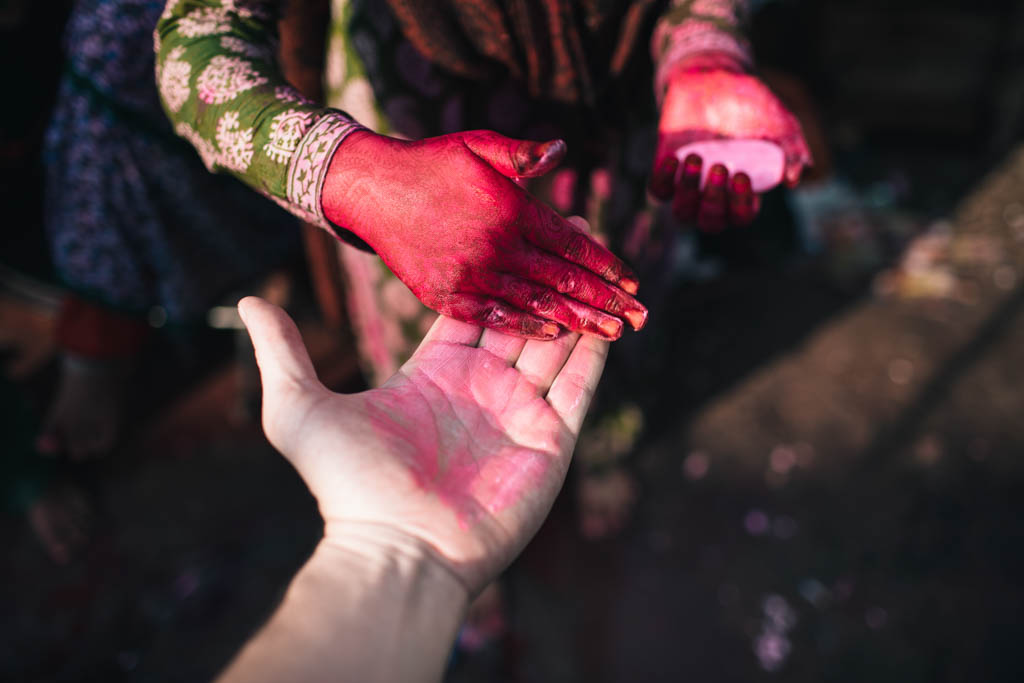Today, we're pleased to begin the December Stories, a series of first-hand accounts of our community's work on important causes and issues around the world. For our first post, photographer Benjamin Heath and Water.org community manager Morée Scofield share about capturing stories of communities and access to safe water. All photos by Benjamin Heath.
We’re Benjamin Heath and Morée Scofield. From Peru to Kenya, to India and Indonesia – we work our way through the countries where Water.org has programs. We photograph and document the lives of the people we serve. Our objective is to capture the autonomy and potential of these people. Why? Because we’ve seen how access to safe water can transform a life of poverty into a life of possibility.

Drawing water in Bangalore, India.

A woman in Mahahalli Village (south of Bangalore) checks on her floral crop.


Above: Morée Scofield travels between villages in Huancayo, Peru near the Andes Mountains; Benjamin Heath and a young girl in India exchange greetings.
Most recently, we spent two weeks working in the Philippines and Cambodia. With our objective in mind, we set out in early November to meet the people, who through small loans called WaterCredit, now have access to safe water and improved sanitation at home.
Our job seems simple – visit a village, Ben takes photos, Moree takes notes, and voila! A story gets created about people who needed water, and got it. But the reality is it’s not that easy. In the case of Cambodia, about 80% of Cambodians live in rural areas. There, water utilities are struggling to secure the resources needed to expand coverage to these regions. So our setting is a rural village, where the residents have little knowledge of, or access to, resources and technology further than walking distance from their homes. And, the people we meet are living on less than $1 USD a day, and usually subsist on a limited supply of food they grow at home. Chances are, many of them never completed or attended school. All of this is compounded by the fact that they have lived most of their lives without access to safe water or a toilet – trapped in a cycle of poverty.
The people we photograph and interview are among the poorest people in the world. Yet, as storytellers we refuse to portray them as anything less than humans with agency, autonomy, and unlimited potential. This is why our job isn’t easy.

Sumyati does her laundry with water from her new tap in Indonesia.

Boys play a game of street soccer while their mothers do laundry.
We view the poor differently, and Water.org views the poor differently. We don’t view the poor merely as recipients of aid, but as catalysts for change. We have seen the disadvantaged as capable of being the change makers in their own lives. Those who live below a country’s poverty line can end up paying 5-15x per liter of water compared to people who live above that poverty line. What Water.org has found, and we have seen first-hand is, if given a choice and an opportunity to pay for water and sanitation improvements with loans, families opt to finance long-term solutions versus struggle day-to-day to find that next liter of water. And, once their solutions are in place, their lives change dramatically. With taps at home, there is a sense of confidence; of pride in the water they can give their families. No longer walking to collect it, they have time to work and attend school, kids can play, and they are healthier. With safe water at home there’s a bright future ahead.

In Indonesia, celebrating the repayment of a WaterCredit loan.
It’s not their dirt floors and tattered clothing we care to share; with each interview and photo we document, we highlight the hopes, dreams, and plans these people have in mind now that their lives are no longer ruled by a lack of safe water. There’s no need to define them by suffering or to strip them of the dignity they deserve. We believe in highlighting the new life their water solution gives.

Rosalie, who lives with her two children and husband in a small village outside of Bacolod, Philippines.
Take Rosalie’s story for example. Rosalie was eager to share her water connection with us. She is the mother of two young children. Her home is made of thatch and tarps. While her husband works as a day-laborer doing odd jobs, she does the domestic chores. She uses water for everything; watering their garden, washing laundry, cooking, bathing, drinking etc. She said because she used to walk to find water, or use other people’s water connections she had to budget every ounce very carefully as it was limited. With regards to the water she purchased she shared, “It was much more expensive than the amount I am repaying on my loan to my tap.” Water affected so much of her finances and time every single day. Rosalie ended our time together saying, “Now I can do so many things in my life like wash dishes when I want, bathe myself and my kids…play with my kids. Water does not control my life anymore.”
We hope you will join us in our efforts to bring more hope to the poor and hopeful stories to the world. If not through your own work, help support Water.org’s work. You can donate and help bring safe water to more women like Rosalie – turning a life of poverty into a life of possibility.
Visit Water.org/give today to support Water.org's work around the world.

